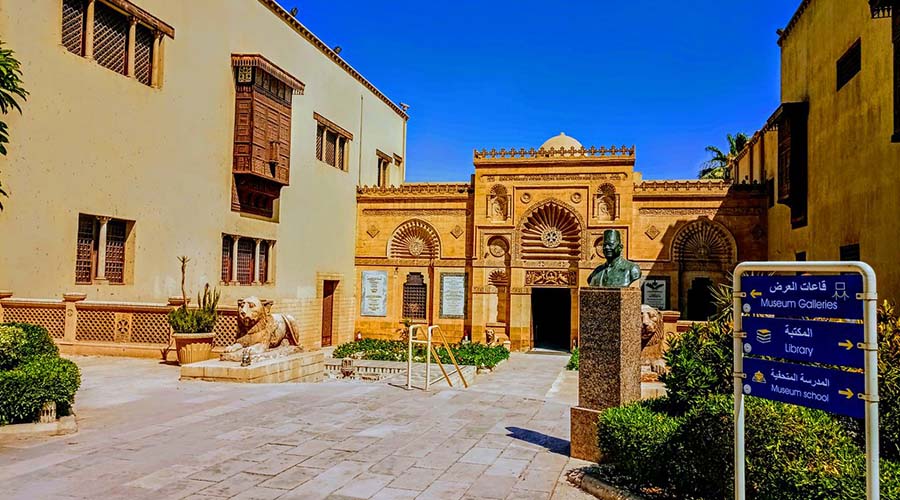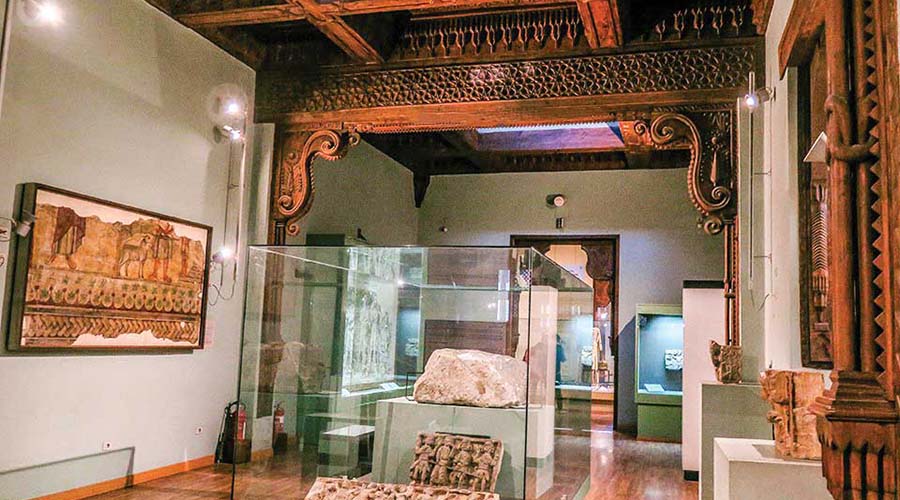Coptic Museum Cairo Egypt tours, booking, prices, reviews
Coptic museum Cairo located in the Old Cairo area in Cairo Egypt. In fact, the Coptic Museum in Cairo located inside the ruins of the Roman Babylon Fortress. Old Cairo is an area full of Coptic sites such as Hanging church, St. George church and St. Barbara church. Nobody would ever believe that the foundation of the Coptic Museum Cairo dates back to the era of the Persians. A lot of items added afterwards by the Roman emperors August and Trajan. French scientist Maspero played a major role in the establishment of the Coptic Museum. He spent a long time collecting Coptic monuments from all around Egypt and preserving it.
In fact, the founder of Coptic Museum Cairo Egypt in modern times is Mr. Smeka Pasha. Moreover, he exerted huge efforts to found the building of the museum. It opened to the public in 1901 with Smeka as the first head of the Coptic Museum in Cairo. The museum today consists of two major sections. The old section established by Smeka Pasha. The other one is the New section. The new section consists of two floors. It opened for the public in 2006 by the president Hosni Mubarak. The renovation of Coptic museum costed 30 million Egyptian pound. In fact, it affected by the earthquake which struck Egypt in 1992.
Further details about The Coptic Museum Cairo Egypt:
In fact, the museum displays around 1600 items. Moreover, they collected from various regions around Egypt. Furthermore, they date back to different centuries in the Coptic history of Egypt. Coptic Museum Cairo indeed is a complete illustration of the Coptic history in Egypt. The old section of the museum contains Ehnasya section. In fact, Ehnasya is a town near Beni Suef to the South of Cairo. Some Coptic items which discovered in that area, date back to the third and forth century AD. The second section is Sakkara section. It is where the ruins of St. Armeia monastery located. It is with a lot of rock structures and a lot of other items. In fact, they gathered from monasteries from the Fayoum and Upper Egypt.
The new two stories of the museum consists of eight sections:
The Stone and portraits section at Coptic Museum Cairo Egypt:
In fact, this section features a stones collection. The collection contains a lot of Tempra style stone drawings. Moreover, the second part of this section contains a huge collection of decorated stone capitals. In fact, they collected from monasteries and churches from all over Egypt.
This section also includes:
1- Patriarchal Throne made of bronze and copper from the 10 century.
2- Portrait of a young man enclosed in a double medallion 5-6 section.
3- A collection of stone capitals from the monastery of Saint Jeremias.
4- A ceiling portrait of Adam and Eve in the Tempra style found in Fyoum in the 11th century.
The metals section at Coptic Museum Cairo Egypt:
In fact, this section contains a large collection of silver and golden Coptic coins. Most of these coins brought from the White Monastery in Sohag. There are also a lot of drawings that carved on silver and other precious metals like:
1- A silver piece of the Virgin holding Jesus.
2- Patriarchal Throne made of bronze and copper from the 10 century
Other items included:
1- Bronze dish with Coptic inscriptions from the 10 century.
2- Censer, Ethiopian, with perforated base and dome made of bronze.
3- Crosses from the Byzantine period.
4- Different keys from the 13 century.
5- The Cross made of Bronze
The wood section at Coptic Museum Cairo:
In fact, The lack of good wood was always the biggest obstacle which faced wooden crafting in Egypt. The Egyptian imported wood since the days of the Pharaohs. The Christian artists used different kinds of woods. The woods are like tamarisk, acacia, sycamore and lebbakh to produce their art. Furthermore, the Coptic museum Cairo hosts a big collection of these wooden items. It includes:
1- A wooden box with ivory or in bone inlays. It intended to store clerical vestments 17-19 century.
2- A wooden door that has many different decoration brought from Marcus church in Rosetta
3- A wooden piece showing people playing music dates back to the 5-6 century
4- Door decorated with geometric designs and bone inlays from the Mamluk period
5- Wooden chair from the 18th century made out of Arabisc.
6- Broken Pediment of the two nude erodes and the cross 4 th century
The ivory section at the Coptic Museum in Cairo:
In fact, Alexandria indeed was a major trade point of ivory in the whole world. It was during the Greek period. In the times of the Roman rule in Egypt Persia became the most important trade focal point for ivory.
The Coptic writings section:
It indeed is one of the most interesting sections of the Coptic Museum Cairo. In fact, it contains bibles written in the 11th and the 13th century. It is on deer skin in the Coptic and Arabic languages. Moreover, there is also a wooden sickle cell. It used to hold the bible. Moreover, it dates back to the 14th and the 15th century. This section also includes:
1- A manuscript by St. Mark, St. Mathew, and St. John from 11th century.
2- Lectionary of the Gospels according to the Greek rite. It is with titles and simple colors decorations 13 Century.
3- Papyrus paper with Christian writings date back to 6-8 century.
4- The book of the Psalms which still has its wooden cover. In fact, it found in Beni Suef. It dates back to 4-5 century.
5- The four Ashier written in Arabic with golden writings
The pottery and glass section at Coptic Museum Cairo Egypt:
The Copts preyed the good quality of the pottery and glass in Egypt to produce their art. In fact, The Coptic museum in Cairo has a lot of pottery items. Moreover, these items date back to the six century AC like:
1- A flask of St. Minas standing between two camels. It dates back to 6-7 century
2- Jar decorated with birds and saints in different posture wearing varied clothes.
3- Painted bowel with a flat scalloped rim of alluvial clay with some human decorations 8 century.
4- Storage jar painted in columns. it represents the bust of human figure, animals, birds and floral designs. They are inside vaults 7 century.
The cloth and textile section in Coptic Museum Cairo Egypt:
In fact, this section includes a lot of monks clothes. Moreover, they decorated with crosses, drawings of the Virgin and the drawings of the Christ. This section also includes:
2- A Kettan robe with ornaments in two columns one is horizontal and the other is diagonal 5-6 century.
3- A part of the Coptic wool with two parallel columns of decorations date back to the 4-5 th century
4- A piece of cloth showing the Virgin and Jesus dates back to the 7th century.
5- A textile of a cross found in Kellia.
6- Christian decorations from Michael monastery, dates back to the 17 century.
7- Fragment of a curtain or a tunic with tapestry decoration dates back to the 6-7 century
The Icons section in Cairo Coptic Museum:
In fact, this section contains a wide collection of Coptic icons from different ears. Moreover, they are with different theme and decorations. One of the styles of these icons called Frisk. The Coptic artists affected by the drawings of the walls of the Pharonic temples. Furthermore, they started drawing on the walls of churches and monasteries. Because of the persecution of the Romans to the Copts, they started drawing on wood and plaster. In fact, they were much easier to held while escaping an attack on a church or a monastery. In fact, the word “Icon” is a Greek word. It means a picture and it may contain a drawing of saints or other religious scenes.
More details:
This section also includes:
1- Icon of St. Andrews the Apostle holding the Holy Bible and a cross dates back to 17-18 century
2- Icon of the crowned Virgin holding the Infant Jesus. They are between two Saints having halos around their heads.
The Virgin’s crown carried by two angles and the Holy Spirit is descending from heaven in the form of dove
3- Icon representing St. Nicolas dates back to 19 century
4- Icon representing St. Menas on horse –back. In fact, He holds the bridle with his left hand. Moreover, he also does piercing a dragon with a long spear with a cross fixed at the top. His crowned head surrounded by a halo
5- Icon representing St. Victor the martyr wearing a crown on horseback. In fact, he holds a cross with his right hand. Moreover, he holds the bridle with the left .Under the horse is a dragon representing the devil
6- Icon representing the Virgin and the Infant holding a golden roll in His hand dates back to 18 century
7- Icon representing two persons. They are Ahrakas and Oghani. They wear masks shaped like dog head. Moreover, they look right towards a bearing fruits tree
The last and maybe most fascinating item of Coptic museum Cairo is the a “Hawdage” or a cart. In fact, it made out of ebony wood inlaid with ivory and mother of pearl. Moreover, it used to transfer rich ladies to Jerusalem in the Roman period.

















